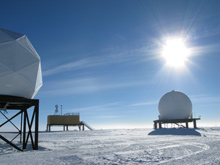|
Ground station on the left, South Pole RF Building and MARISAT-GOES Terminal complex in the background. Photo Credit: Gary Ferentchak
The National Science Foundation (NSF) Office of Polar Programs (OPP) finished modernizing the South Pole TDRSS Relay (SPTR) in January 2009, significantly enhancing high-speed science data communications for Amundsen-Scott South Pole Station. A new earth station with a 4 meter parabolic antenna, accompanied by state-of-the-art, software-defined modulator/demodulators, was commissioned to replace the original earth station installed in 1997. The SPTR uses aged satellites operating in inclined geosynchronous orbit from the NASA Tracking and Data Relay Satellite System (TDRSS) to provide high-speed data communications and Internet Protocol (IP) access for advanced research programs at South Pole Station. The new earth station can transmit at 150 Mb/s on a dedicated data link, allowing for over 200 gigabytes (GB) to be sent daily from the station to universities and collaborating institutions world-wide. Commissioning tests reached an Antarctic record of 239.7 GB sent "north" on January 27, 2009. A second parallel 5 Mb/s link provides network service to connect the South Pole Station to the outside world. The earth station is "agile" in azimuth and elevation such that it can point to any NASA TDRS satellite longitude that has sufficient inclination to be visible from the South Pole Station. The primary beneficiaries of this capability are the major research projects IceCube The remoteness and physical isolation of the experiments at South Pole Station are largely overcome via the "tele-projection" of technical expertise from a wide array of university and institutional participants world-wide. Daily delivery of data for additional advanced processing, reduction, and analysis at computing facilities co-located with the participating science teams facilitates the delivery of research analysis results that can be shared with the broader science discipline communities (via conferences, peer-reviewed papers, etc.), which in turn generates beneficial peer input for evolving experiment design and goals. This increased data communications capability brings South Pole Station and its active research programs more effectively into cyberspace, and hence into the public's awareness via modern networking applications. Improved data networking capability has enabled greater use of higher quality video conferencing, timely sharing of pre-produced public outreach videos, telephone interviews, etc., enabling the NSF to share more effectively the exciting results of its science research programs with the public (for example, see Ice Stories: Dispatches from Polar Scientists Program Officer, Patrick Smith For more information about the new satellite communications system, read Keeping Connected |



For USAP Participants |
For The Public |
For Researchers and EducatorsContact UsU.S. National Science FoundationOffice of Polar Programs Geosciences Directorate 2415 Eisenhower Avenue, Suite W7100 Alexandria, VA 22314 Sign up for the NSF Office of Polar Programs newsletter and events. Feedback Form |


